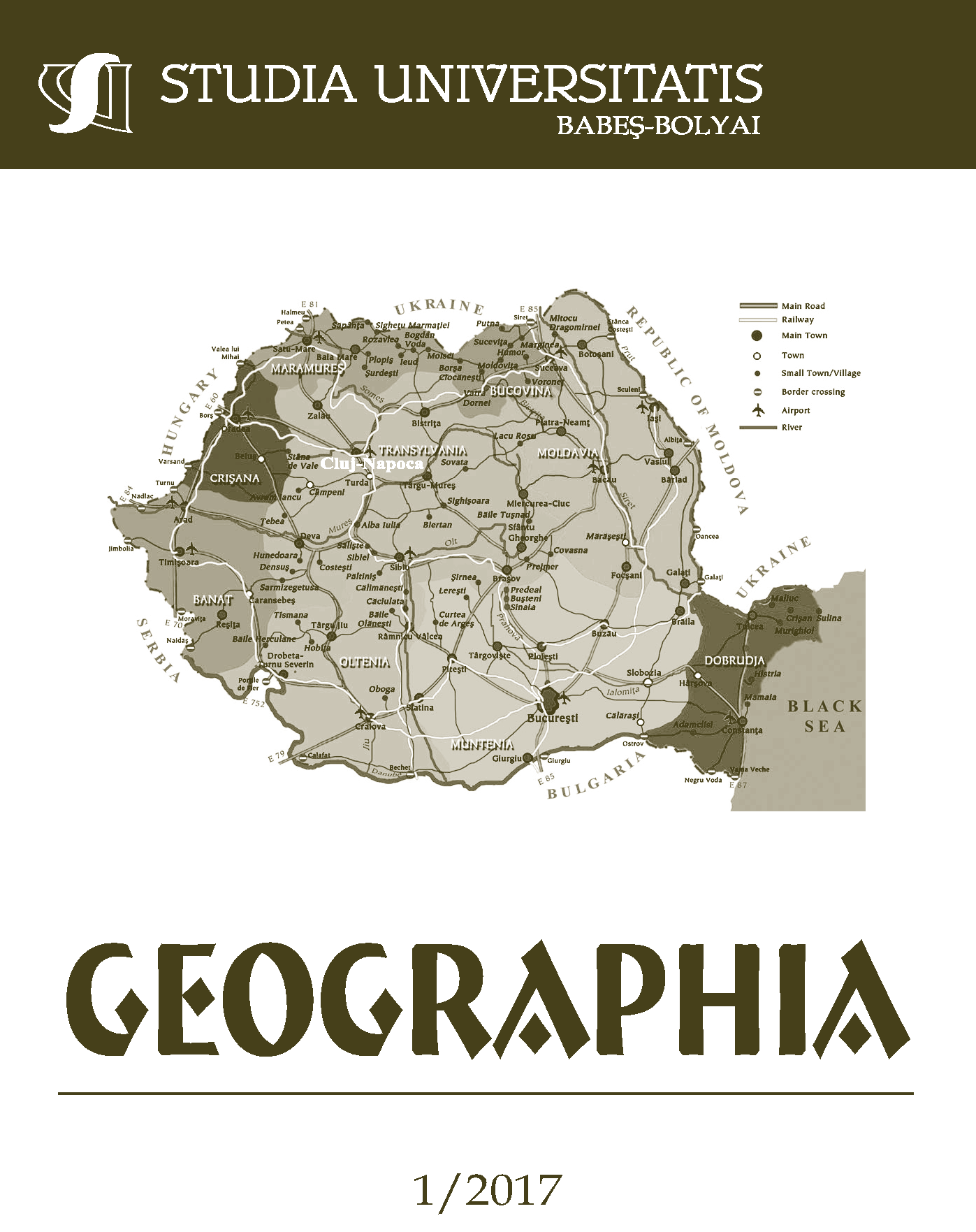RELATIONAL ANALYSIS OF SUSCEPTIBILITY TO LANDSLIDES OF SETTLEMENTS SITUATED IN THE EASTERN AND CENTRAL PART OF ALBA IULIA HINTERLAND, USING GIS TECHNOLOGY AND MAXENT SOFTWARE
DOI:
https://doi.org/10.24193/subbgeogr.2017.1.03Keywords:
vulnerability, settlements, GIS, MaxEnt, Alba Iulia, hinterland, ROC curve.Abstract
Relational analysis is an important method to analyze, generate and to predict relevant data about natural or men-made hazards. In this study, we have chosen to investigate different relations between landslides and landslide causing factors, interpolating the results and their impact on settlements. Urban and rural settlements are highly prone to landsliding because of the increased population which lives in the affected territories. Therefore, an assessment of landslide susceptibility becomes an important phase to predict the most vulnerable settlements of a certain territory in order to implement different disaster mitigation plans/works and land planning strategies. Our study area has a high tendency to landslide due to its lithological and morphological structure. Thus, our purpose is to generate a reliable and accurate analysis of the settlements using the susceptibility map generated by the MaxEnt software, based on 8 identified landslide causing factors: slope angle, slope aspect, profile and plan curvature, terrain roughness, depth of fragmentation, precipitation and temperature. The resulted map indicates a high value of accuracy, the area under the curve (AUC) showing a high performance (0.925) of our analysis.References
Bayes, A. (2015). Landslide susceptibility modelling applying user-defined weighting and data-driven statistical techniques in Cox’s Bazar Municipality, Natural Hazards, pp. 1707-1737.
Chen, W., Chai, H., Sun, X., Wang, Q., Ding, X., Hong, H. (2016). A GIS-based comparative study of frequency ratio, statistical index and weights-of-evidence models in landslide susceptibility mapping, Arab J Geosci.
Chung, C.J.F., Fabbri, A.G. (2003). Validation of spatial prediction models for landslide hazard mapping, Natural Hazards, pp. 451–472.
Conforti, M., Robustelli, G., Muto, F., Critelli, S. (2011). Application and validation of bivariate susceptibility assessment for the Vitraro river catchment (Calabria, south Italy), Natural Hazards.
Davis, J.D., Sims, S.M. (2013). Physical and maximum entropy models applied to inventories of hillslope sediment sources, J. Soils Sediments, pp. 1784–1801.
Davis, J.D., Blesius, L. (2015). A Hybrid Physical and Maximum-Entropy Landslide Susceptibility Model, Entropy.
Elith, J., Phillips, S., Hastie, T., Dudík, M., Chee, Y., Yates, C. (2011). A statistical explanation of MaxEnt for ecologists, Divers. Distrib., pp. 43–57.
Felicisimo A.M., Auroracuartero, Remondo J., Quiros, E. (2012). Mapping landslide susceptibility with logistic regression, multiple adaptive regression splines, classification and regression trees, and maximum entropy methods: a comparative study, Landslides, pp 175-189.
Jaynes, E.T. (1957). Information theory and statistical mechanics. Phys. Rev., 106, pp. 620–630.
Nicula, S.A., Păcurar, B.N., Constantin Veronica, Blaga Oana, Rus, I. (2015). Development policies in Alba Iulia’s influence area. An integrated approach, Studia UBB Geographia, LX, 1, 2015.
Pop, G.P. (2012). Depresiunea Transilvaniei, Edit. Presa Universitară Clujeană, Cluj-Napoca.
Pradhan, B., Lee, S. (2010). Delineation of landslide hazard areas on Penang Island, Malaysia, by using frequency ratio, logistic regression, and artificial neural network models, Environ Earth Sci, pp. 1037–1054.
Philiphs, S.J., Anderson, R., Schapire, R. (2005). Maximum entropy modeling species geographic distribution, Ecological modelling, pp. 231-259.
Riley, S., Degloria, S., Elliot, R. (1999). A terrain ruggedness index that quantifies topographic heterogeneity, Intermountain Journal of Science, pp 23-27.
Roșian, Gh. (2009). Evoluţia versanţilor afectaţi de alunecări masive de tip glimee. Studiu de caz: versantul drept al Văii Secaului Mic (sectorul Tău – Secăşel), Geographia Napocensis, III, 1, pp. 33 – 40.
Roșian Gh., Horváth, Cs., Réti Kinga-Olga, Boțan, C.N., Gavrilă Ionela Georgiana (2016). Assessing landslide vulnerability using bivariate statistical analysis and the frequency ratio model. Case study: Transylvanian Plain (Romania), Zeitschrift fur Geomorphologie, 60, 4, pp. 359 – 371.
Surdeanu, V. (1998). Geografia terenurilor degradate, Edit. Presa Universitară Clujeană, Cluj-Napoca, p 274
Swets, J.A. (1988). Measuring the accuracy of diagnostics systems, Science, pp. 1285-1293.
United Nations (2004). Reducing Disaster Risk, A Challenge for Development, United Nations Development Programme.
Yalcin, A. (2008). GIS-based landslide susceptibility mapping using analytical hierarchy process and bivariate statistics in Ardesen (Turkey): Comparisons of results and confirmations, Catena, 72, 1, pp. 1-12.
Downloads
Published
How to Cite
Issue
Section
License
Copyright (c) 2017 Studia Universitatis Babeș-Bolyai Geographia

This work is licensed under a Creative Commons Attribution-NonCommercial-NoDerivatives 4.0 International License.





 ©Studia Universitatis Babeş-Bolyai Geographia. Published by Babeș-Bolyai University.
©Studia Universitatis Babeş-Bolyai Geographia. Published by Babeș-Bolyai University.